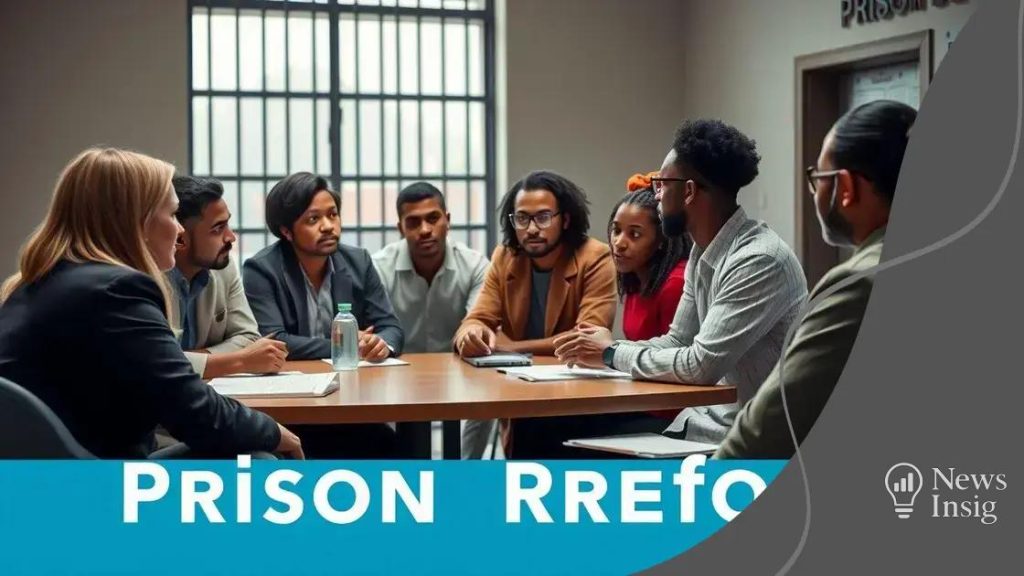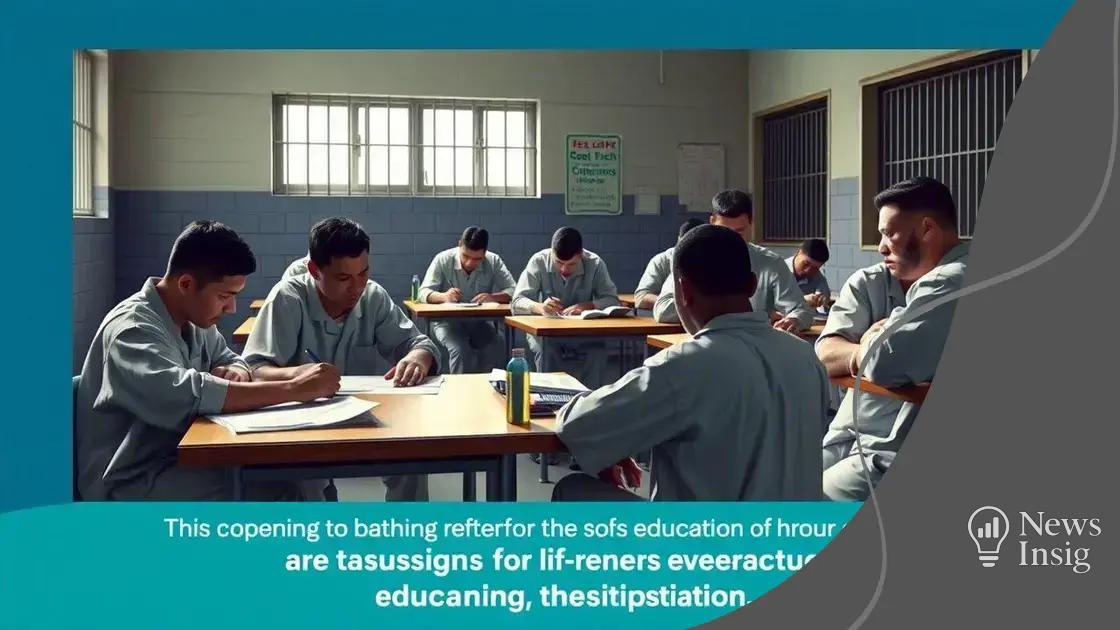Prison reform: A path to a fairer justice system

Anúncios
Prison reform focuses on transforming the justice system to prioritize rehabilitation over punishment, reducing recidivism rates through education, mental health support, and effective community reintegration initiatives.
Prison reform has become a critical topic in today’s justice conversations. Many wonder how changes can lead to a more equitable system and impact society as a whole. Let’s delve into the intricacies of this important subject.
Anúncios
Understanding the need for prison reform
Understanding prison reform is essential for creating a justice system that works for everyone. Many individuals feel that the current penal system does not offer fair treatment or real chances of rehabilitation. As society evolves, so should our approach to dealing with crime and punishment.
The importance of addressing reform
Criminal justice reform is not just about changing laws; it’s about changing lives. Many people are affected by the consequences of incarceration, including families and communities. The need for reform can be seen in several areas:
- Overcrowding: Many prisons operate beyond capacity, leading to dangerous living conditions.
- Recidivism rates: A significant percentage of those released return to prison due to a lack of support.
- Disparities in sentencing: Minorities often face harsher penalties compared to others for similar crimes.
- Inadequate mental health support: Many inmates require treatment that is not provided within the prison system.
Anúncios
Prison reform aims to address these issues by providing solutions that focus on rehabilitation instead of simply punishment. By implementing changes to training programs, education, and mental health services, we can help people reintegrate into society as productive members.
Voices for reform
Many organizations and advocates work tirelessly to promote the need for prison reform. They emphasize the role of community support and how restorative justice can lead to better outcomes for offenders and their victims. Engaging communities in discussions about reform helps raise awareness and encourages action.
People are beginning to realize that reform is not just beneficial for those within the prison system; it also contributes to the overall safety and health of our communities. By prioritizing rehabilitation, we can reduce crime rates and foster a more just society, ensuring that everyone has a chance to succeed.
Key challenges in the current system
The current prison system faces numerous challenges that hinder its ability to rehabilitate offenders and maintain public safety. These obstacles must be addressed to create a more effective approach to justice. Some of these key challenges are widely recognized and impact the overall functionality of the penal system.
Overcrowding and its impact
Overcrowding is one of the most pressing issues. Prisons are often filled beyond their intended capacity. This results in unsafe environments for inmates and staff, as well as limited access to essential services. For instance, overcrowding can hinder access to education and vocational training, which are vital for reducing recidivism.
- Inadequate living conditions: High inmate populations lead to poor sanitation and health risks.
- Increased violence: More inmates can escalate tensions and conflict within facilities.
- Insufficient resources: Overcrowded facilities struggle to provide adequate healthcare and mental health services.
Addressing overcrowding is essential for ensuring that prisons can effectively serve their rehabilitative function. Other significant challenges include high recidivism rates and disparities in sentencing that disproportionately affect marginalized communities.
Recidivism and lack of rehabilitation
A major goal of the prison system should be to reduce recidivism. Unfortunately, many individuals released from prison return, as they often lack support or resources to reintegrate successfully. Education and job training programs are crucial, yet they are frequently underfunded and underutilized in many correctional facilities.
Sentencing disparities also pose a significant challenge. Certain groups face harsher sentences compared to their peers for similar offenses. This inequity can undermine public trust in the justice system, making reform even more critical.
Mental health issues further complicate the current system. Many inmates struggle with mental health problems that are not adequately addressed in prison. Implementing better mental health services could improve outcomes and promote rehabilitation.
Effects of prison reform on recidivism

Understanding the effects of prison reform on recidivism is crucial for determining whether changes to the system are effective. Several studies show that well-implemented reform strategies can lead to significant reductions in reoffending rates. By addressing the root causes of criminal behavior, we can improve outcomes for individuals and society.
Educational programs and their impact
One of the most effective ways to reduce recidivism is through education. Inmates who participate in educational programs are less likely to return to prison after release. Providing access to high school diplomas, vocational training, and higher education not only equips individuals with skills but also boosts their self-esteem and helps them find stable employment.
- Job readiness: Educational programs enhance employability, making it easier for individuals to reintegrate.
- Skill development: Learning new skills helps individuals adapt to changing job markets.
- Reduced stigma: Education may help lessen the stigma associated with having a criminal record.
This shows that education can play a crucial role in supporting successful transitions back into society.
Mental health and support services
Mental health support is another critical aspect of reducing recidivism. Many individuals in the prison system face untreated mental health issues, which can contribute to their criminal behavior. Providing access to mental health services during and after incarceration can lead to lower reoffending rates.
Therapy and counseling help address the underlying issues that often lead to criminal activity. When individuals receive the necessary help, they are more likely to manage their emotions and behaviors effectively. Furthermore, community support services can assist in this transition, offering resources for housing, employment, and counseling.
Additionally, programs focused on restorative justice have been shown to reduce recidivism rates significantly. These programs emphasize rehabilitation over punishment and involve the community, victims, and offenders in the healing process. By fostering understanding and accountability, they help individuals reconnect with their communities and reduce the likelihood of returning to crime.
Successful prison reform initiatives worldwide
Examining successful prison reform initiatives worldwide can provide valuable insights into innovative strategies that improve systems. Many countries have implemented reforms that demonstrate the potential for positive change. These initiatives not only aim to reduce recidivism but also focus on creating safer, more humane environments for inmates.
Norway’s rehabilitative approach
Norway is known for its focus on rehabilitation over punishment. The country’s prisons emphasize education, therapy, and job training. Inmate facilities, like Halden Prison, feature a more open environment that resembles a community rather than a traditional prison. Inmates have access to:
- Education programs: Inmates can pursue degrees and vocational training.
- Work opportunities: Many prisons have work programs that teach skills.
- Mental health services: Comprehensive support is provided to address mental health needs.
This approach has significantly reduced recidivism rates, demonstrating that treating inmates with dignity can lead to better outcomes.
Germany’s focus on social reintegration
Germany also offers a noteworthy model of prison reform. The country prioritizes social reintegration by maintaining family connections through regular visitations. Inmates have the opportunity to spend time with their families, which helps maintain their social bonds. Moreover, their prison system includes:
- Community service programs: Inmates can serve their communities while fulfilling their sentences.
- Individualized rehabilitation plans: Each inmate’s needs are assessed to create a unique plan.
- Support after release: Programs continue beyond incarceration to help reintegrate individuals into society.
This focus on social ties reduces the feelings of isolation and creates pathways for successful reentry into society.
New Zealand’s holistic practices
New Zealand has adopted a more holistic approach to prison reform. The country has introduced programs that integrate cultural practices, especially for indigenous populations. These initiatives emphasize healing and community involvement, ensuring that reform is culturally sensitive. Effective elements in New Zealand include:
- Restorative justice programs: These allow for dialogue between victims and offenders.
- Community involvement: Engaging local communities helps create support systems for ex-offenders.
- Therapeutic environments: Prisons focus on creating environments conducive to healing.
These models showcase how diverse approaches can effectively address the challenges within prison systems. By learning from these successful initiatives, other countries can begin to implement similar reforms that promote rehabilitation and lower recidivism.
The role of public opinion in driving reform
The role of public opinion in driving prison reform is significant and cannot be underestimated. As society becomes more aware of the shortcomings of the current justice system, the demand for reform grows stronger. Public awareness and advocacy can lead to policy changes that better address the needs of inmates and communities.
Impact of media coverage
Media coverage plays a crucial role in shaping public opinion. Documentaries, news articles, and social media discussions spotlight the issues within the justice system. When stories about the negative aspects of incarceration reach the public, they can stir emotions and provoke discussions about possible solutions. For example:
- Highlighting injustices: Coverage of wrongful convictions and harsh sentencing fuels calls for reform.
- Personal stories: Sharing individual experiences makes the impact of incarceration more relatable to the public.
- Raising awareness: Media can educate the public on the benefits of rehabilitative justice over punitive measures.
This heightened awareness often translates into increased pressure on lawmakers to enact necessary changes.
Grassroots movements and activism
Grassroots movements are vital to advocating for prison reform. Groups driven by passionate individuals work tirelessly to mobilize public support. These movements create forums for discussion and encourage citizens to voice their concerns. Successful initiatives often stem from collective efforts that include:
- Petitions and campaigns: Gathering signatures to demonstrate widespread support for reform.
- Community events: Hosting discussions, workshops, and rallies to educate and encourage activism.
- Coalitions: Collaborating with various organizations to amplify the message.
Through these efforts, grassroots movements influence local and national policies, making reform a priority among decision-makers.
Moreover, as public opinion shifts toward more humane practices, legislators may feel compelled to support programs that focus on rehabilitation rather than punishment. The growing recognition of mental health issues in prisons and the effectiveness of community-based alternatives also plays a significant role in changing public sentiment.
Ultimately, public opinion acts as a catalyst for change, showing that when citizens unite for a cause, meaningful transformation is possible within the justice system.
FAQ – Frequently Asked Questions about Prison Reform
What is the main goal of prison reform?
The main goal of prison reform is to create a more just and rehabilitative justice system that reduces recidivism and promotes successful reintegration into society.
How does education impact recidivism rates?
Education programs significantly lower recidivism rates by providing inmates with skills and qualifications that enhance their employability upon release.
What role does public opinion play in driving reform?
Public opinion is crucial as awareness and advocacy can pressure lawmakers to implement necessary reforms that improve the justice system.
Can mental health support in prisons improve outcomes?
Yes, comprehensive mental health support helps address the underlying issues that contribute to criminal behavior, leading to better rehabilitation outcomes.





